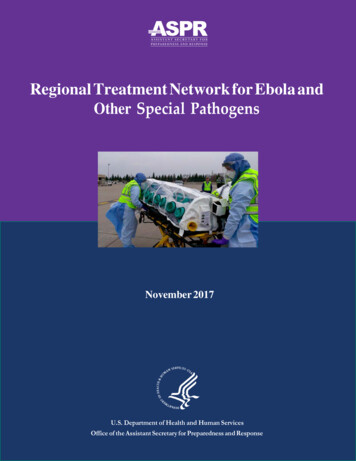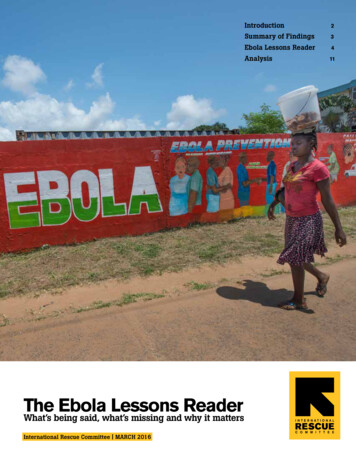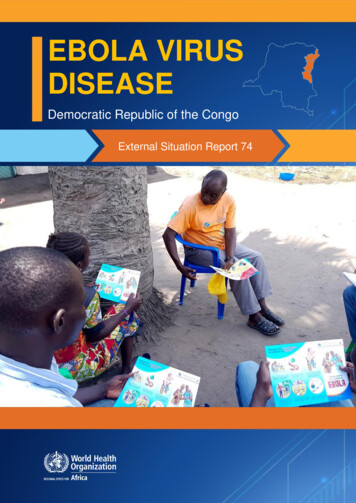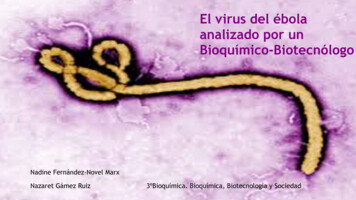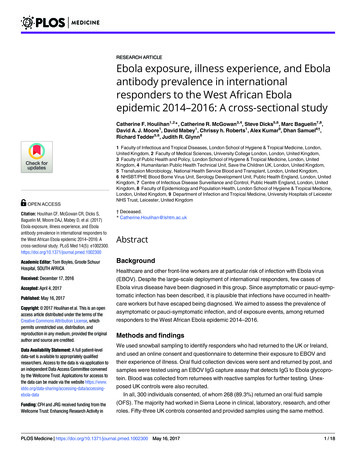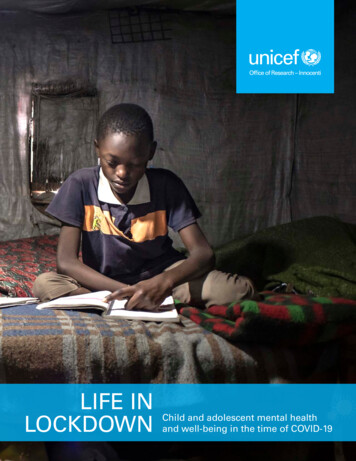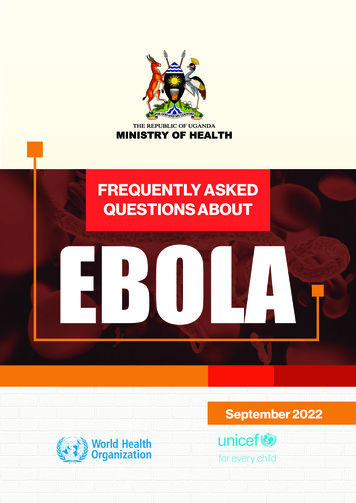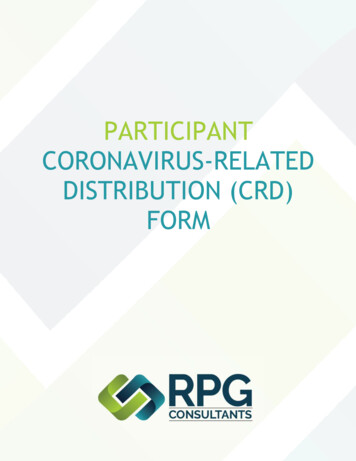
Transcription
EBOLA VIRUS DISEASEFACT SHEETOverviewEbola, previously known as Ebola hemorrhagic fever, is a rare and deadly diseasecaused by infection with one of the Ebola virus species. Ebola can cause disease inhumans and nonhuman primates (monkeys, gorillas and chimpanzees).Ebola is caused by infection with a virus of the family Filoviridae, genus Ebolavirus.There are five identified Ebola virus species, four of which are known to causedisease in humans: Ebola virus (Zaire ebolavirus); Sudan virus (Sudan ebolavirus);Taï Forest virus (Taï Forest ebolavirus, formerly Côte d’Ivoire ebolavirus); andBundibugyo virus (Bundibugyo ebolavirus). The fifth, Reston virus (Restonebolavirus), has caused disease in nonhuman primates, but not in humans.The natural reservoir host of Ebola virus remains unknown. However, on the basisof evidence and the nature of similar viruses, researchers believe that the virus isanimal-borne and that bats are the most likely reservoir. Four of the five virusstrains occur in an animal host native to Africa.Signs and SymptomsSymptoms of Ebola include: Fever;Severe headache;Muscle pain;Weakness;Fatigue;Diarrhea;Vomiting;Abdominal (stomach) pain; andUnexplained hemorrhage (bleeding or bruising).Symptoms may appear anywhere from two to 21 days after exposure to Ebola, butthe average is eight to 10 days.Recovery from Ebola depends on good supportive clinical care and the patient’simmune response. People who recover from Ebola infection develop antibodies thatlast for at least 10 years.Causes and TransmissionBecause the natural reservoir host of Ebola viruses has not yet been identified, the1
way in which the virus first appears in a human at the start of an outbreak isunknown. However, scientists believe that the first patient becomes infectedthrough contact with an infected animal, such as a fruit bat or primate (apes andmonkeys), which is called a spillover event. Person-to-person transmission followsand can lead to large numbers of affected people. In some past Ebola outbreaks,primates were also affected by Ebola and multiple spillover events occurred whenpeople touched or ate infected primates.When an infection occurs in humans, the virus can be spread to others throughdirect contact (through broken skin or mucous membranes in, for example, theeyes, nose or mouth) with: Blood or body fluids (including but not limited to urine, saliva, sweat, feces,vomit, breast milk and semen) of a person who is sick with or has died fromEbola;Objects (like needles and syringes) that have been contaminated with bodyfluids from a person who is sick with Ebola or the body of a person who hasdied from Ebola;Infected fruit bats or primates (apes and monkeys); andSemen from a man who has recovered from Ebola (for example, by havingoral, vaginal or anal sex).A person who has recovered from Ebola illness can no longer transmit the disease,except through semen. The virus may persist in semen for several months; it is notyet known how long the virus remains in semen.Ebola is not spread through the air, by water, or in general, by food. However, inAfrica, Ebola may be spread as a result of handling bushmeat (wild animals huntedfor food) and contact with infected bats. There is no evidence that mosquitoes orother insects can transmit Ebola virus. Only a few species of mammals (inparticular, humans, monkeys, apes and fruit bats) have shown the ability to spreadEbola virus after becoming infected with it.Health care providers caring for Ebola patients and family and friends in closecontact with Ebola patients are at the highest risk of getting sick, because they maycome in contact with infected blood or body fluids. During outbreaks of Ebola, thedisease has the potential to spread within health care settings (such as a clinic orhospital) unless careful infection control is practiced. Exposure to Ebola can occur inhealth care settings where clinical staff are not wearing appropriate personalprotective equipment. Laboratory workers are also at risk.Dedicated medical equipment (preferably disposable, when possible) should beused by health care personnel providing patient care. Proper cleaning and disposalof instruments, such as needles and syringes, also are important. If instruments arenot disposable, they must be sterilized before being used again. Without adequatesterilization of instruments, virus transmission can continue and amplify anoutbreak.2
Ebola virus has been found in the semen of some men who have recovered fromEbola. It is possible that Ebola could be spread through sex or other contact withsemen. It is not known how long Ebola might be found in the semen of male Ebolasurvivors. The time it takes for Ebola to leave the semen is different for each man.Based on the results from limited studies conducted to date, it appears that theamount of virus decreases over time and eventually leaves the semen, but it maytake months. It is not known if Ebola can be spread through sex or other contactwith vaginal fluids from a woman who has had Ebola.Risk FactorsHealth care providers caring for Ebola patients and family and friends in closecontact with Ebola patients are at the highest risk of getting sick because they maycome in contact with infected blood or body fluids. Ebola also can be spreadthrough direct contact with objects (like clothes, bedding, needles, syringes/sharpsor medical equipment) that have been contaminated with infected body fluids.Sexual transmission can occur, as described above. Additionally, people canbecome sick with Ebola after coming in contact with infected wildlife. For example,in Africa, Ebola may spread as a result of handling bushmeat (wild animals huntedfor food) and contact with infected bats.ComplicationsApproximately 50 percent of Ebola patients die from the disease, either due tosevere dehydration from vomiting and diarrhea or as a result of multiple organfailures.Survivors of Ebola commonly experience neurologic, eye and musculoskeletalproblems. Other long term symptoms include headaches, joint pain and hearingproblems.The virus may persist in immune-protected areas such as the eyes and testes longafter it has cleared from a patient’s bloodstream.Tests and DiagnosisDiagnosing Ebola in a person who has been infected for only a few days is difficultbecause the early symptoms, such as fever, are nonspecific to Ebola infection andoften are seen in patients with more common diseases, such as malaria and typhoidfever.However, a person should be isolated and public health authorities notified if he/shehas the early symptoms of Ebola and has had contact with: Blood or body fluids from a person sick with or who has died from Ebola;Objects that have been contaminated with the blood or body fluids of aperson sick with or who has died from Ebola;Potentially infected animals such as African fruit bats, apes and monkeys;andSemen from a man who has recovered from Ebola.3
Samples from the patient can then be collected and tested to confirm infection.Ebola virus is detected in blood only after onset of symptoms, most notably fever,which accompany the rise in circulating virus within the patient's body. It may takeup to three days after symptoms start for the virus to reach detectable levels.There are laboratory tests that can be used to diagnose Ebola within a few daysafter symptoms begin, later in the disease course, after recovery from illness orafter a patient dies.TreatmentsNo FDA-approved vaccine or medicine (e.g., antiviral drug) is available for Ebola.Symptoms of Ebola and complications are treated as they appear. The followingbasic interventions, when used early, can significantly improve the chances ofsurvival: Providing intravenous fluids (IV) and balancing electrolytes (body salts);Maintaining oxygen status and blood pressure; andTreating other infections if they occur.Experimental vaccines and treatments for Ebola are under development, but theyhave not yet been fully tested for safety or effectiveness.Recovery from Ebola depends on good supportive care and the patient’s immuneresponse. People who recover from Ebola infection develop antibodies that last forat least 10 years, possibly longer. It is not known if people who recover areimmune for life or if they can become infected with a different species of Ebola.PreventionThere is no FDA-approved vaccine available for Ebola.If you travel to or are in an area affected by an Ebola outbreak, make sure to dothe following: Practice careful hygiene. For example, wash your hands with soap and wateror an alcohol-based hand sanitizer and avoid contact with blood and bodyfluids (such as urine, feces, saliva, sweat, urine, vomit, breast milk, semenand vaginal fluids).Do not handle items that may have come in contact with an infected person’sblood or body fluids (such as clothes, bedding, needles and medicalequipment).Avoid funeral or burial rituals that require handling the body of someone whohas died from Ebola.Avoid contact with potentially infected animals such as African fruit bats,monkeys and apes, or blood, fluids and raw meat from these animals. Avoid4
health care facilities where Ebola patients are being treated. The U.S.embassy or consulate is often able to provide advice on facilities.Avoid contact with semen from a man who has had Ebola until you knowEbola is gone from his semen.After you return, monitor your health for 21 days and seek medical careimmediately if you develop symptoms of Ebola.Health care workers who may be exposed to people with Ebola should follow thesesteps: Wear appropriate personal protective equipment (PPE).Practice proper infection control and sterilization measures.Isolate patients with Ebola from other patients.Avoid direct, unprotected contact with the bodies of people who have diedfrom Ebola.Notify health officials if you have had direct contact with the blood or bodyfluids, including, but not limited to, feces, saliva, urine, vomit and semen of aperson who is sick with Ebola. The virus can enter the body through brokenskin or unprotected mucous membranes in, for example, the eyes, nose ormouth.Disease PatternsEbola viruses are found in several African countries. Ebola was first discovered in1976 near the Ebola River in what is now the Democratic Republic of the Congo.Since then, outbreaks of Ebola among humans have appeared sporadically in Africa.The 2014 West Africa outbreak is the largest Ebola outbreak in history and the firstEbola outbreak in West Africa. It is the first Ebola epidemic the world has everknown. See the Centers for Disease Control and Prevention’s page on the 2014Ebola Outbreak in West Africa for more information.Additional InformationCenters for Disease Control and Prevention: http://www.cdc.gov/vhf/ebola/World Health Organization: /This fact sheet provides general information. Please contact your physician forspecific clinical information.Last reviewed/updated: June 20, 20165
A person who has recovered from Ebola illness can no longer transmit the disease, except through semen. The virus may persist in semen for several months; it is not yet known how long the virus remains in semen. Ebola is not spread through the air, by water, or in general, by food. However, in
